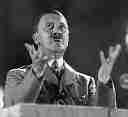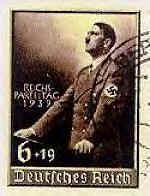|
|
|
|
In July 1933, Hitler announced to the Reich Governors that the Nazi revolution was over: The achievement of outward power must be followed by the inward education of man... Revolution is not a permanent state. The full spate of revolution must be guided into the secure bed of evolution. In this the most important part is played by the education of the people. The present state of affairs must be improved and the people embodying it must be educated in the National Socialist conception of the State.
This was the Nazi concept of Gleichschaltung - 'bringing into line'. It was not just a matter of taking power; Germany, and the German people, had to be TRANSFORMED by National Socialism. Everything they, did, said and thought had to be brought into line with National Socialism.
The first part of this was for the Nazis to take total political and social control:
|
Going DeeperThe following links will help you widen your knowledge: BBC Bitesize webpages on Control and Opposition
Simple pages from my KS3 series
Was Hitler a 'weak dictator'? - difficult but VERY important article
Podcasts
YouTube Hitler establishes power - BBC video (watch the second half, from the 9-minute mark). Pete Jackson on Nazi control of Germany, and over the Churches
|
Six Ways to Control Germany[Overdo The Power You Worthless Rogue]What were the levers that maintained Nazi control over the German population? Within a one-party state, Hitler used terror to keep power, underpinned by propaganda and indoctrination of the young. There were special measures to keep the workers happy. Hitler signed a Concordat with the Pope, which stopped Catholics opposing him.
1. One-Party StateThe Enabling Act (23 March 1933) made Hitler was the all-powerful Fuhrer of Germany. The Law against the Formation of Parties (14 July 1933) declared the Nazi Party the only political party in Germany. It was an offence to belong to another Party. All other parties were banned, and their leaders were put in prison. Nazi Party members, however, got the best jobs, better houses and special privileges. Many businessmen joined the Nazi Party purely to get orders.
|
"Ein Volk, Ein Reich, Ein Fuhrer!" - one people, one empire, one leader.
|
2. TerrorThe Nazis took over local government and the police. On 26 April 1933, Hitler set up the Gestapo (the secret police) and the SS, and encouraged Germans to report opponents and 'grumblers'. Tens of thousands of Jews, Communists, gypsies, homosexuals, alcoholics and prostitutes were arrested and sent to concentration camps for 'crimes' as small as writing anti-Nazi graffiti, possessing a banned book, or saying that business was bad. On the Night of the Long Knives (13 June 1934) Hitler used his legal power to assassinate all his opponents within the Nazi Party.
|
|
3. Propagandahe German people were subjected to continual propaganda, under the control of Josef Goebbels. It was the cult of personality - everything was organised to make Germans permanently grateful to Adolf Hitler. Germans were made to feel part of a great and successful movement - in this respect the 1936 Olympic Games were a propaganda coup. The Nazis used the most up-to-date technology to get their message across.
|
Even stamps encouraged Germans to idolise Adolf Hitler.
Nazi Art
- a very difficult site with, however, lots of links |
4. YouthHitler boasted: 'When an opponent declares, 'I will not come over to your side', I calmly say, 'Your child belongs to us already'. The Nazis replaced anti-Nazi teachers and University professors, and school lessons included hidden indoctrination - requiring children to calculate how much mentally disabled people cost the state, or to criticize the racial features of Jewish people. German boys were required to attend the Hitler Youth, which mixed exciting activities, war-games and Nazi indoctrination. German girls went to the BDM and learned how to be good mothers, and to love Hitler.
|
Education for Death - wartime (1943) Disney anti-Nazi propaganda on growing up as a Nazi. |
5. WorkforceHitler banned all Trade Unions on 2 May 1933. Their offices were closed, their money confiscated, and their leaders put in prison. In their place, Hitler put the German Labour Front which reduced workers' pay and took away the right to strike. The National Labour Service sent men on public works programmes. To keep the workers happy, the Nazis set up the Strength through Joy movement, which offered good workers picnics, free trips to the cinema and (for the very few) free holidays.
|
|
6. ReligionHitler signed a Concordat with the Pope, agreeing to leave the Roman Catholic Church alone if it stayed out of politics - so most Catholics were happy to accept the Nazi regime. Protestants and Jehovah's Witnesses - if they opposed the Nazis - were sent to concentration camps.
|
|
|
| |

